Natural zones of Russia: map, titles, geographical characteristics and table
The natural zone is called part of the earth's surface with a similar terrain, soil, fluoro and fauna. The main generation factor of the natural zone is climate. In Russia, 8 natural complexes were formed. They replace each other from north to south. The most small territory occupies the most small - the semi-desert area and desert. Below is a distribution card and a geographical description of all natural zones in Russia, as well as a table with a brief characteristic of each natural zone.
See also:
Map of natural zones of Russia
Arctic desert
The upper line of the region passes through the archipelago of the land of Franz Joseph, the lower border on the island of Wrangel. The main feature is the presence of ice and snow throughout the year. The average temperature in winter is about -50º C. During this period, a lot of snow falls out, strong winds blow. Polar night lasts 4 months. Summer temperatures on average are + 4º C. August is considered the warmest month of the year.
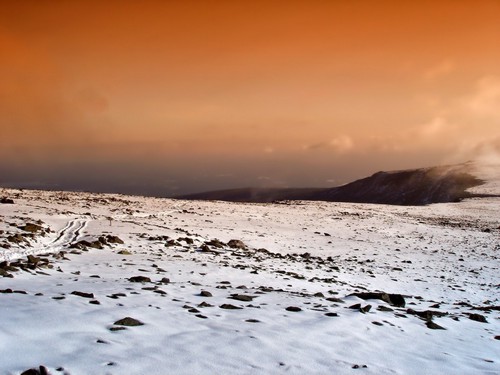
Lakes and swamps are absent. The plant world is presented mainly by lichens. Here you can count several endemics: Arctic Iva, Pushi, forget-me-not, and star. Not enough because of the scarce flora. In the cold desert, white bears, sands, northern deer and lemmings feel great. The rocky coasts were chosen by Gaga, Cayra and other birds. The shores of some islands are solid bird bazaars.
Tundra
The natural complex stretched from the Kola Peninsula to Chukotka. Its area is the eighth of the entire area of \u200b\u200bRussia. Characterized by the plains, only near the Urals appear mountains and hills. It is characterized by a harsh winter with average temperatures about -32º C and a duration of more than six months. During the winter season, strong winds blow, which remove the snow layer from the soil. Because of this, the soil freezes, and during thaws it feels. Polar night continues from December to February.
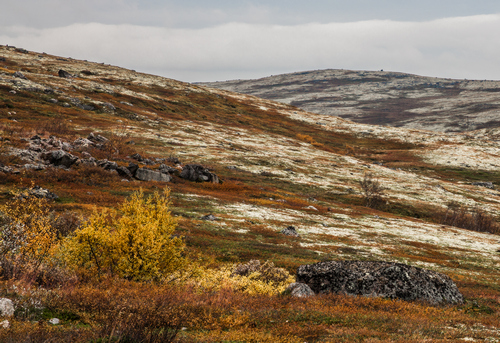
From the middle of summer the sun does not sit down. It does not rise high above the horizon, therefore, most of the rays is dissipated in the atmosphere. There is a so-called polar day. Summer average temperatures in the tundra do not exceed + 5º C. Lichens of all sorts of species and mossi received special distribution. Perennial cultures are represented by stone, lingonberries, a richness, Cassandra and cloudberry. are a feed database for reindeer and hares. In addition to them, wolves, sands and partridges. During the short summer, you can watch the gagars, hugs and geese.
Lesotundra
The region stretches from the tundra to the taiga. The climate in this transition zone is much softer than in the neighboring North. In January, the thermometer column does not rise above -40º C, cold winds constantly blow. However, snow cover lies constantly. Winter lasts up to eight months. The average summer temperature is 15º C. due to high humidity and relatively low summer temperatures of the soil are very frozen.
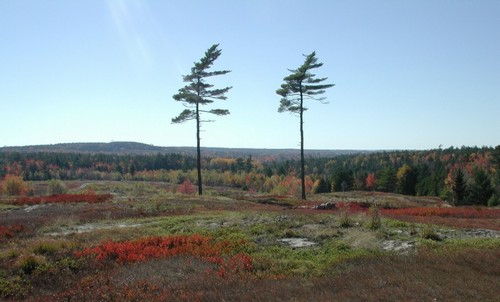
Latstundra is characterized by forests consisting of hardwood trees, birch and fir trees. Another feature of the plant world are meadows. Late spring, medicinal herbs flourish on them. The swampy terrain is rich in peat and mkhami. In this natural region, a yagel is growing, which is a power source for deer. The world of mammals is varied than in the tundra. You can observe wolves, bears, wolves and sands. Swamps, lakes and rivers are populated by waterfowl: ducks, swans and gagars. In the forest tundra, the unique feathers are found: Sapsans, sparks and barracks. Some birds, for example, White Owl and Partridge, live in this natural zone all year round, not dear away.
Taiga
It stretches from Western borders to the coast of the Pacific Ocean. Bioma area is about 15 million km². Most of the territory occupy forests. Mostly the terrain is practically intact by a person. The Taiga Winter is cold, the average temperature is -29 ° C. Snow cover does not melt more than three months. Summer indicators on average are + 18º C. The precipitation is presented in the form of heavy rains, due to which the level of humidity increases.

The natural zone is represented by numerous rivers, lakes and other reservoirs. The soil layer consists of humus and a large amount of minerals. and unique. Coniferous and deciduous forests are widely represented in the taiga zone. In addition to them there are wetlands and meadows. Due to the sustainable climate and the absence of extreme temperatures, most animals do not change habitats all year round. Ryakchik, cedigrovka, the wooder do not fly away, but constantly nest in the taiga.
For the climate turned out to be severe. Little frogs and lizards fall into anabiosis with the onset of stable frosts. The world is represented by Romolosha, Lynx, Else, Burym Bear, Sobat. Taiga is saturated with bloodsowing insects, which are pioneering in huge quantities. Often the GNUS is a carrier of infectious diseases.
The territory extends from the Eastern European Plain to the Far East. Biom is characterized by a mild climate. Winter temperatures does not exceed -25 ° C. Above the Far East during this period, numerous anticyclones are formed. Snow evenly covers the entire territory of the natural complex. Summer is basically soft and wet. The July air warms up to + 20º C. The warm period lasts 4 months. At this time, the maximum amount of rain falls.

The territory of mixed and large forests is known for its aquatic potential. There are extended flood rivers, lakes. The swamps are practically absent. The earth is saturated with nitrogen, magnesium, calcium and aluminum. Cedar Korean, Walnut Manchursky, Lipa Amur, larch grows in the forests. Very a lot of shrubs. Mosses and lichens cover the soil only in dark and raw places. Forests are rich in fruit, berry plants and mushrooms. This creates conditions for a comfortable stay of many animal species. These forests are most used by a person in their activities. The greatest species diversity is distinguished by land untouched by man.
From the dwelling you can highlight a viper, a borious lizard, hor. In the forests there are various feathers: Ryabchik, Tetra, Klest, Philin, Owl. The natural zone is rich in predators - wolves, mountainous, foxes, cunits are its constant inhabitants. Recently, the number of deer has significantly decreased. Forests stay home for hedgehogs, badgers, nutria, moles, hares and marsh turtles.
LESSWARE ZONE
The territory that united the Eastern European Plain, the West Siberian Plain and the Southern Urals, and is a transitional forest and steppes. Winter in the western part of the natural zone is very soft and multiserful. The temperature in the East is lowered to -20 ° C, the snow falls a bit. Summer temperature indicators on average are + 18º C, rain falls a bit.

For characteristic combination of forests and herbaceous cover. Maple, Oak, Lipa grows in the European part. Osins and birch predominate in the Asian zone. Steppe areas are rich in mint, clover. Almost the entire steppe is used in agriculture. People cultivate corn, rye, wheat. There are such animals such as squirrel, cunnic, horse, drought, elk.
The anthropogenic factor led the forest-steppe zone to desertification, land and water bodies are contaminated with toxic substances and nitrates. Unstable vegetation world can not recover after human activity. The natural structure of the forest-steppe gradually disappears in Russia.
Steppe zone
The natural zone is located on the East European Plain and in Western Siberia. In winter, in the eastern part of the zone is colder than in the West. In summer, the average temperature of the temperature is + 20 ° C. The maximum amount of precipitation falls on June. There is an alternation of wet seasons with arid. Soil is black earth, well suited for growing cereals. In some areas, the erosion process is underway.
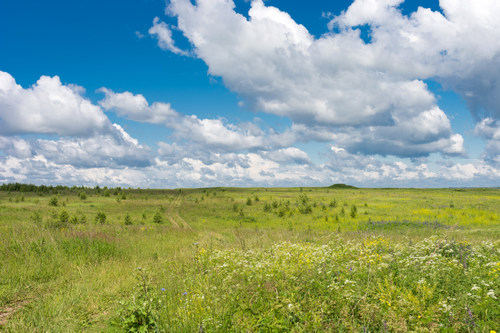
In the steppe prevailing herbal vegetation: clover, mint, wild oats. Sometimes there are shrubs on the ground: the rocket, spirire, deresis and turn. All plants are an excellent feed base for animals. In the steppes there are a large number of pools, surkov and food. The world is represented by ferrets, foxes and wolves. In this natural complex, there is an area of \u200b\u200bpredatory feathered: owls, hawks, moon and kanyukov.
Semi-desert and desert
The territory stretches from the Caspian lowland to borders with Kazakhstan. The thermometer column in winter is lowered to -16º C, blowing winds blowing. There is practically no snow, so the soil is deeply freezing. The maximum number of precipitation falls on the short spring period. The average temperature in the summer is + 25 ° C. Sloated lands, many sands and salt marshes.
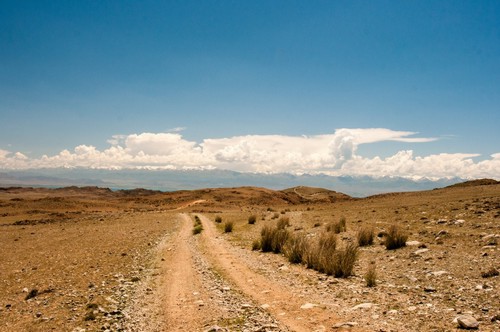
The plant world does not differ in variety. Only here you can see Reyaria, Malkomia, Acacia, camel bit, cacti and some cereals. During drought, some plants are faded by keeping underground organs. The most recognizable desert tree is Saksaul. It practically lacks the leaves, which significantly reduces the evaporation of moisture. From herbaceous plants known is black wormwood, which shelters the land, protecting it from drought.
The inhabitants of the desert lead. Susliki, tushkans and gerbils can fall into the hibernation with the onset of heat. The world of amphibians are represented by geccons, boobs and varanas. From predators, you can mark Corsars, wolves and foxes. Saigas and camel are large. From the birds there are larks, sadzhj and garption.
Table of Natural Zones of Russia
| Name of the natural zone | Geographical location | Climate | Soil | Animals and plants |
| Arctic desert | The upper line of the zones passes through the archipelago of the Land of Franz Joseph, the lower border - on the island of Wrangel. | The average temperature in the winter is lowered to -50ºС. Summer temperatures on average are + 4ºC. August is considered the warmest month. | Eternal Frost | Animals: White bears, sands, reindeer, lemming, gaga and cake; Plants: Lichens, Arctic Iva, Pucizian, forget-me-not, and star. |
| Tundra | Tundra stretched from the Kola Peninsula to Chukotka, and takes the eighth of the entire area of \u200b\u200bRussia. | The region is characterized by a harsh winter with average temperatures about -32º C and a duration of more than six months. Summer average temperatures in the tundra do not exceed + 5º C. | Tundrovo Gley and Peat | Animals: Wolves, sands, hares, reindeer and partridges. During the short summer, you can watch the gagars, hugs and geese. Plants: Lichens and moss. Perennial plants are represented by stone, lingonberries, a richness, Cassandra and cloudberry. |
| Lesotundra | The area extends from the tundra to the taiga. | The climate is much softer than in the tundra. In January, the thermometer column does not rise above -40º C, cold winds constantly blow. The average summer temperature is 15º C. | Peat-gley, peat-marsh and guery-podzolic | Animals: Lemming, earthroowing, northern deer, brown bears, sands, partridges, polar owl, variety of types of migratory and waterfowl. Plants:forests consisting of hardwood trees, birch and fir trees. Grass grow on the meadows, and in a swampy terrain there are many moss and lichen. |
| Taiga | The taiga zone stretches from the western borders of the country to the coast of the Pacific Ocean. Taiga Square is about 15 million km² | Winter is cold, the average temperature is -29 ° C. Snow cover does not melt more than three months. Summer indicators on average are + 18º C. The precipitation is presented in the form of heavy rains and snow. | Dernovo-podzolic | Animals:ryys, wolverines, wolves, foxes, brown bears, otters, sables, caress, mountainous, hares, burzubs, beavers, chips, mice, firewalls, proteins, flying, northern and noble deer, moose, roe. Plants:coniferous and deciduous species of trees, juniper, honeysuckle, currant, blueberry, lingonberry and various types of herbs. |
| Wide and mixed forests | The territory extends from the Eastern European Plain to the Far East. | Climate zone soft. Winter temperatures does not exceed -25 ° C. The snow evenly covers the entire territory of the natural complex. Summer is basically soft and wet. July air warms up to + 20º C. Warm season lasts 4 months. At this time, the maximum amount of precipitation falls. | Dernovo-podzolic | Animals:wolves, ermine, foxes, cunits, hedgehogs, badgers, nutria, moles, hares, marsh turtles, viper, viviors, lizards, crooks, tanks, twiners, cheeks, fibilies, owls. Plants:cedar Korean, Walnut Manchursky, Lipa Amur, larch. Very many shrubs and herbs. Mossi and lichens cover the soil only in dark and raw areas. Forests are rich in fruit, berry plants and mushrooms. |
| Forest-steppe | Transition zone between forests and steppes. | Winter in the western part of the natural zone is very soft and multiserful. The temperature in the East is lowered to -20 ° C, the snow falls a bit. Summer temperature indicators on average is + 18º C. | Chernozem | Animals:squirrels, cunits, horses, drofs, moose. Plants: Maple, Oak, Lipa grows in the European part. Osins and birch predominate in the Asian region. Steppe areas are rich in mint, clover. People cultivate corn, rye, wheat, etc. |
| Steppe | The natural zone is located on the East European Plain and in Western Siberia. | In winter, in the eastern part of the steppe as colder than in the West. In summer, the average temperature of the temperature is + 20 ° C. The maximum amount of precipitation falls on June. There is an alternation of wet seasons with arid. | Chernozem | Animals: Wheels, Surki, food, ferrets, foxes, wolves, owls, hawks, luni and cannuki. Plants: Clover, Mattik, Wild Oats, Ratchnik, Spirea, Dereza and Turn. |
| Semi-desert and desert | The territory stretches from the Caspian lowland to borders with Kazakhstan. | The thermometer column in winter is lowered to -16º C, blowing winds blowing. There is practically no snow, so the soil is deeply freezing. The maximum number of precipitation falls on the short spring period. The average temperature in the summer is + 25 ° C. | Soil saline, many sands, solonts and salt marshes. | Animals: Susliki, Tushkanchiki, Glovers, Gecko, Blow, Varana, Corsairs, Wolves, Foxes, Saigas, Larks, Saddies and Birds. Plants:remarya, Fleece, Acacia, Camel Quick, Cacti, Grands, Saksaul and Black Wormwood . |
If you have found a mistake, please select the text fragment and click Ctrl + Enter..









